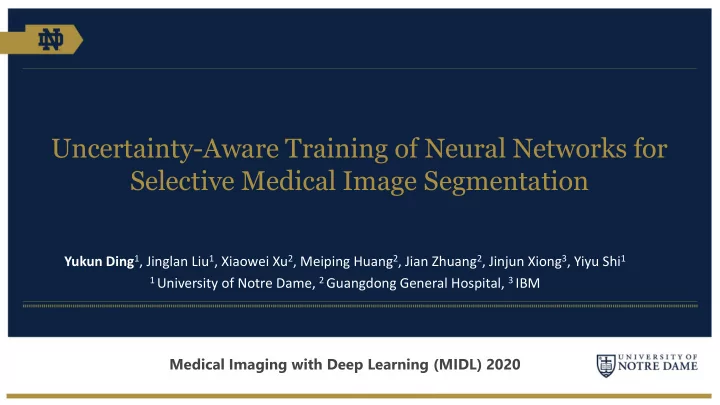

Uncertainty-Aware Training of Neural Networks for Selective Medical Image Segmentation Yukun Ding 1 , Jinglan Liu 1 , Xiaowei Xu 2 , Meiping Huang 2 , Jian Zhuang 2 , Jinjun Xiong 3 , Yiyu Shi 1 1 University of Notre Dame, 2 Guangdong General Hospital, 3 IBM Medical Imaging with Deep Learning (MIDL) 2020
Overview • Background • Motivation • Method • Results • Limitation and Future Work 2
Uncertainty of DNNs I’m not sure I can Why we need to consider the uncertainty? • do the work now – Real-world problems are diverse Identify and deal with potential failure properly – • The word “uncertainty” can be tricky e.g., This is a tumor, but I think there is a 30% of chance I’m wrong – – This is a tumor, rotate the image a bit -> this is not a tumor • What uncertainty are we consider here? – For each input , the model outputs prediction , and the uncertainty score – The uncertainty score indicates how likely the prediction is wrong – A popular baseline of uncertainty estimation: 1 - (softmax probability) 3
Selective Prediction Input Output w/ human-level accuracy Output w/ sub-human-level accuracy Human (a) DNN Human (b) Model DNN Human (c) Model 4
Motivation Selective segmentation • • The practical target and training target : 5
Problems Definition For each input , model outputs prediction , and the uncertainty • score , the correctness score if the prediction is correct, otherwise • If we apply a threshold on the uncertainty, we divide the input data into two subset and , the coverage is defined as • Consider the accuracy at coverage c • Our practical target, accuracy at coverage c, depends on both the quality of prediction and the quality of uncertainty estimation We know how to optimize our neural network for prediction, but not for • uncertainty 6
From the Scoring Rule Perspective Estimating the uncertainty is a probabilistic prediction problem • • Scoring rule: – A quantified summary measure for the quality of probabilistic predictions Proper scoring rule: • – Denote the truth distribution as 𝑟 and the predicted distribution as 𝑞 𝜄 , a scoring rule ℎ is a proper scoring rule if ℎ(𝑞 𝜄 , 𝑟) ≤ ℎ(𝑟, 𝑟) 𝑞 • Strictly proper scoring rule: – Same as the proper scoring rule, but ℎ 𝑞 𝜄 , 𝑟 = ℎ 𝑟, 𝑟 if and only if 𝑞 𝜄 = 𝑟 • Commonly used loss functions are strictly proper scoring rule E.g., Cross Entropy, L2 – – This is why softmax probability can be a strong baseline for uncertainty estimation 7
Observation For the uncertainty estimation in selective segmentation, we do not need a strictly proper scoring rule that tries to recover the actual distribution 𝑟 . • The uncertainty score u is only used to divide the data into two subset, we only want more correct predictions go to the low uncertainty subset and 𝑞 more wrong predictions go to the high uncertainty subset. • Even if we consider all possible coverage, only the relative ranking of u matter and we don’t care the specific value of u . So we try to find a better optimization target that is not a strictly proper • scoring rule. 8
The Uncertainty Target • Why : – is a proper scoring rule but not a strictly proper scoring rule – fully determines with – The partial derivative is always positive 9
Uncertainty-Aware Training How to optimize ? • • The uncertainty-aware training loss: 10
The Dice-Coverage Curve Reduced coverage leads to higher accuracy • • Uncertainty-aware training outperforms the baseline 11
Quantitative Results Reduced coverage leads to higher accuracy • • Uncertainty-aware training outperforms the baseline AURC 12
Qualitative Results Input Error at c=0.9 Error at c=0.9 Uncertainty Error at c=1 Uncertainty Error at c=1 (Ours) (Ours) (Ours) 13
Per-Image Comparison The performance is improved by uncertainty-aware training • • With decreasing average coverage – Per-image coverage difference increases – Per-image Dice difference decreases 14
Limitation and Future Work It is not very efficient to do pixel-wise selective segmentation • – We are currently looking at image-wise selective segmentation Challenges: image-wise uncertainty measure; joint training – • is a proven good target, but the is not – A better loss to optimize ? Or even directly optimize ? 15
Thank You! • • Q&A 16
Recommend
More recommend